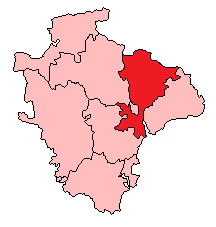| Tiverton | |
|---|---|
| Former county constituency for the House of Commons | |
 Tiverton in Devon 1983-1997 | |
| County | Devon |
| 1885–1997 | |
| Seats | One |
| Replaced by | Tiverton & Honiton |
| 1621–1885 | |
| Seats | Two |
| Type of constituency | Borough constituency |

Tiverton was a constituency located in Tiverton in east Devon, formerly represented in the House of Commons of England until 1707, Great Britain until 1800 and after 1801 the Parliament of the United Kingdom. Enfranchised as a parliamentary borough in 1615 and first represented in 1621, it elected two Members of Parliament (MPs) by the first past the post system of election until 1885. The name was then transferred to a county constituency electing one MP. (Between 1885 and 1918, the constituency was alternatively called Devon, North East.)
Contents
- Boundaries
- Members of Parliament
- Tiverton borough, 1621–1885
- County constituency, 1885–1997
- Election results
- Elections in the 1830s
- Elections in the 1840s
- Elections in the 1850s
- Elections in the 1860s
- Elections in the 1870s
- Elections in the 1880s
- Elections in the 1890s
- Elections in the 1900s
- Elections in the 1910s
- Elections in the 1920s
- Elections in the 1930s
- Elections in the 1940s
- Elections in the 1950s
- Elections in the 1960s
- Elections in the 1970s
- Elections in the 1980s
- Elections in the 1990s
- See also
- Notes and references
- Sources
In 1997, it was merged with the neighbouring constituency of Honiton to form the Tiverton and Honiton constituency.
Prime Minister Lord Palmerston was a former MP for the seat.


